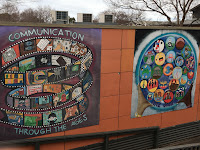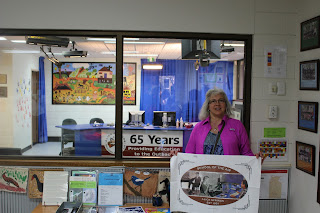Friday, July 22, 2016
Day 2 Keynote 1
Dr. Bronwyn Stuckey "Growing Gameful"
Find your own gameful place to ignite learning!
Take Away:
Growing Gameful is not just about playing games: inspire learning!
Jim Gee's book: What Video Games Have to Teach Us about Learning and Literacy
The discourse/conversation that people have “around the game”
powerful learning is socially constructed, think laterally
Get gameful:engage with non-game environments in a gameful way (like protractor near the swing)
Build game around the narrative/tell an engaging story/deconstruct the game and tell the narrative/
make play part of your journey/ Ex: Chore Wars
What does it look like when gameful goes to school?
Make recycling a fun thing to do (hoops over bin)
Take Away: message to get across: teachers are learners too!
A good game community for classes
Craft learning management - designed as a multiplayer game
Simple Quest: google form
Complete challenges and teacher’s spreadsheet updates
(use as intro to new content)

Grammar Olympics
Stop thinking of fun as giggles
Take Away: The fun is in the challenge!
Topic signal
Topic is not intrinsically interesting or engaging
Name assignments in a fun way
Engage by bringing in fun
Engagement signal
learners switched off by traditional learning
giving learners new experience of success
Context signal new curriculum
Take Away:
in gaming, students try and try again: they are less likely to give up!
Day 2 Workshop 1
The Crisis of the Introvert
Presenter:
Kathryn McGilvary
Consider the personalities of both students and colleagues
Twitter: @kathmcg1
Myers Brigg Personality Test: ESTJ
Extroverted Sensor Thinker Judger
Activity: photo language cards: find an image that relates to an introvert
Take Away: Introverts take longer to process!
Personality Profile Portal: Kingdomality
How is your classroom learning space arranged? Flexible learning space? Learning space for all learning styles? Sitting/standing/small group/individual???
Check out paint that you can write on the wall!
Take Away: What can you do in the learning space for the introvert?
Learning circle - everyone is equal, including the teacher, no technology
the waterhole space for incidental conversation?
Get ideas from others on how you can improve your learning space:
Where can students publish their work?
Youtube creator studio: (easier than MovieMaker)
Take Away: Draw on introverts because they have a different take on things!
Day 2 Workshop 2
Digital Technologies: Next Steps at Years 7 & 8
Katrina Falkner & Rebecca Vivian (not available)
Presenter: Claudia
MOOC: Massively Open Online Community
Years 7& 8
Overview of project streams
Examples of projects
Why Digital Technologies?
- allows understanding and appreciation of the difficulties
- allows for innovative thinking
- how does it impact
- how does it solve problems
Take Away: CS is about solving problems!
Year 7 & 8
Evaluate: talk about what they have done and practice giving/receiving feedback
Design Thinking
Systems Thinking
Enchanting (looks like Scratch - but can work on Lego Minecraft Robots (free software)
Australian Digital Technologies Curriculum
"The Computer Science Education Research Group, CSER, at the University of Adelaide, have developed a number of open, online courses designed to assist teachers in addressing the new Digital Technologies learning area. These courses cover an introduction to concepts and example activities that help teach Computer Science and Computational Thinking at primary and secondary levels. While explicitly connected with the Australian Curriculum, these courses are open to anyone who wishes to learn more about how they could teach Computational Thinking at these levels."
Take Away:
Check out this resource!
Day 2 Keynote 2
Martin Levins "What have we learned?"
Levins.net
Take Away: The single most successful element of BYOD is “trust”
STEM/STEAM/STREAM
STEM is not equal to coding!
Valve employee handbook:
Develop self sufficient problem solvers!
What if I screw up? Mistakes are opportunities for learning!
How do I manage change? Stay purpose driven —create “low cost of failure” increments
Constantly communicate—— get the right people to do this
Invest in people—they’re your biggest asset
Persist—with friends
Take Away:
Take action as a change leader for learning improvement!
Day 2 Workshop 3

Global Connections and Being a Teacherpreneur
Presenter:
Jolanta Stephens
Jolanta Stephens
Twitter: @jolantastephens
Teacherpreneur
Certified Global Educator
@julielindsay
@flatconnection
Janet Farrell
Getting students to create professional learning networks with other students, experts, etc
“good reads”
Edmodo: Connect culturally with schools / Teach about digital citizenship
Need to be flexible
Today’s Meet: 140 characters
Approach Twitter with a Growth Mindset

dave mulder @D_Mulder
check out Jolanta’s blog
kids blogging
Weekly Education
Auasma
Makers Empire
Jolanta has a huge collection of ideas and resources! I am so excited to begin a global collaboration project with her and a teaching partner (Jess). I will spend some time in their classroom next week!
Another full day of learning! Again, I love all the take-aways! The fun is in the challenge! I have many more connections to follow for my professional learning network and many resources to explore. What an amazing opportunity to participate in this event. #FFTFellow2016




















































